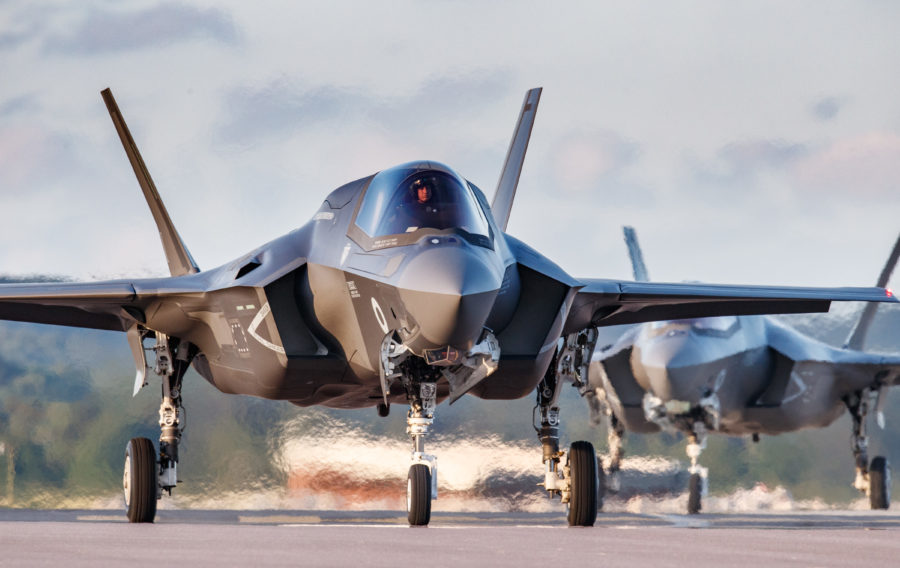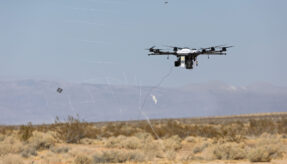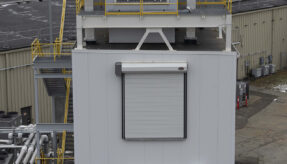
If you have even a passing interest in aviation, you are likely to have heard of the F-35 Lightning II – Lockheed Martin’s hotly anticipated advanced fighter jet.
Heralded as the next generation multi-variant, multi-role aircraft, the Lightning integrates advanced stealth capabilities with the speed, agility and performance of a 21st century fighter jet. Cutting-edge sensor technology will enable the F-35 to carry out intelligence, surveillance and reconnaissance, and electronic attack manoeuvres – traditionally the province of a small cohort of highly specialised aircraft.
This versatility has made the Lightning a must have for any nation eager to establish or preserve air superiority. Among them, the United Kingdom – one of nine original partner countries – which welcomed home the first tranche of four F-35B variants in June, two months ahead of schedule.
A breakneck flight across the Atlantic Ocean took the four aircraft from the US Marine Corps Air Station in Beaufort, South Carolina – where Royal Air Force and Royal Navy pilots have undergone extensive F-35 training – to RAF Marham in Norfolk. At the helm, pilots from the newly re-formed 617 Squadron, world-renowned for the legendary Dambusters’ raid of World War II.
The arrival of the F-35 marks a major milestone for Britain’s Armed Forces, with more planes to follow later on in the year. Overall, the UK has procured 138 Lightning fighter jets, and these will be jointly operated by both the Royal Air Force and the Royal Navy.
“This aircraft will truly transform how the UK conducts its defence operations and it is fitting that the next generation of combat air power has arrived as the RAF celebrates its centenary,” said Peter Ruddock, Chief Executive of Lockheed Martin UK.
“As a key partner in the F-35 programme from its early stages, the UK has been instrumental in shaping the design and development of the aircraft, particularly in relation to the short take-off and vertical landing capabilities.”
From a training standpoint, the F-35 is a single-seat fighter jet, requiring all pilots to fly solo. Therefore, the flyers must first cut their teeth in a Hawk Advance Jet Trainer before transitioning to the F-35 proper, accompanied by a flight instructor in a second aircraft.
In January, Flight Lieutenant Liam became the first Royal Air Force pilot to fly the F-35B. This was a flight he would not soon forget: “It was a sensational experience and, as the culmination of many years’ training, was certainly the highlight of my time in the RAF so far. I was astonished at the jet’s performance and at how well the simulator had prepared me for taking the Lightning flying.
“Much of the first flight is about exploring the aircraft’s performance envelope and breaking the sound barrier was a particular highlight. It is easy to see why every pilot here loves flying the aircraft and I am eager to press on and get stuck in to operating the Lightning and exploring it’s potential.”
To date, around £550 million has been invested at RAF Marham in order to ready the station for the new Lightning fleet. To this end, facilities have been comprehensively refurbished, runways resurfaced and landing pads built to accommodate the aircraft’s ability to land vertically.
“In the RAF’s centenary year, it’s great to see the most advanced and dynamic fighter jet in our history arrive at RAF Marham – and with the modern Dambusters in the cockpit, this homecoming truly feels like an historic moment in British airpower,” commented Air Chief Marshal Sir Stephen Hillier, Chief of the Air Staff.
“If you can’t see us coming, you won’t be able to stop us, so with its stealth and other world-beating technologies the F35 Lightning takes the Royal Air Force and Royal Navy to a whole a new level of capability.”
Meanwhile, the inaugural landing of the F-35 will take place this autumn on the flagship HMS Queen Elizabeth as part of the next phase of Royal Navy trials. Having both the carrier and aircraft in operation together will be another major milestone for the Armed Forces.
According to the First Sea Lord, Admiral Sir Philip Jones: “Ever since aircraft first operated to and from ships, the Royal Navy has been at the forefront of maritime aviation and the arrival of our first F35Bs in the UK, flown by both RAF and Fleet Air Arm pilots, is another important milestone on the way to restoring our place as leaders in the field of aircraft carrier operations.
“Once combined with our new aircraft carriers, HMS Queen Elizabeth and her sister ship HMS Prince of Wales, these extraordinary jets will sit at the heart of our country’s globally deployable expeditionary forces and provide the potent conventional deterrent we need to ensure our national security.“
With a collective worth of $1.3 trillion, the F-35 represents the biggest defence programme in the world today, and Britain stands to benefit greatly. UK industry accounts for 15% of every Lightning fighter jet delivered – over 3,000 in total. Already, the programme has generated $12.9 billion in orders and, at peak production, it will support thousands of British manufacturing and engineering jobs at a time when job security is most in doubt.
If you would like to join our community and read more articles like this then please click here.







